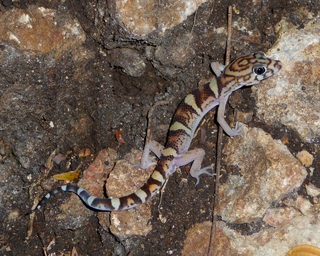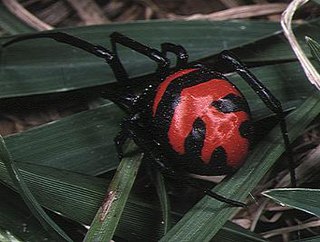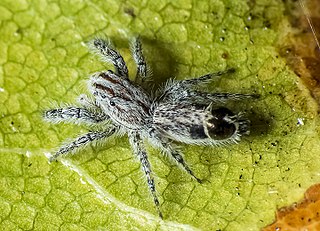
Caenorhabditis elegans is a free-living transparent nematode about 1 mm in length that lives in temperate soil environments. It is the type species of its genus. The name is a blend of the Greek caeno- (recent), rhabditis (rod-like) and Latin elegans (elegant). In 1900, Maupas initially named it Rhabditides elegans. Osche placed it in the subgenus Caenorhabditis in 1952, and in 1955, Dougherty raised Caenorhabditis to the status of genus.

Latrodectus is a broadly distributed genus of spiders with several species that, together, are referred to as true widows. This group is composed of those often loosely called black widow spiders, brown widow spiders, and similar spiders. However, such general "common names" are of limited use as the diversity of species is much greater. A member of the family Theridiidae, this genus contains 32 species, which include several North American "black widows". In addition to these in North America are also the red widow Latrodectus bishopi and the brown widow Latrodectus geometricus, which, in addition to North America, has a much wider geographic distribution. Elsewhere, others include the European black widow, the Australian redback black widow, several different species in Southern Africa that can be called Button spiders, and the South American black widow spiders. Species vary widely in size. In most cases, the females are dark-coloured, but some may have lighter bodies or even reddish. Many can have red, white or brown markings on the upper-side (dorsal) of the abdomen. Some can be readily identifiable by reddish markings on the central underside (ventral) abdomen, which are often hourglass-shaped.
In biology, a homonym is a name for a taxon that is identical in spelling to another such name, that belongs to a different taxon.

Udvardya is a genus of jumping spider endemic to New Guinea. As of 2017, it contains only one species, Udvardya elegans.

Laurieipterus is a genus of a eurypterid classified as part of the family Stylonuridae. It contains one species, L. elegans from the Early Silurian of Scotland.

The Yucatán banded gecko is a species of geckos found in Mexico, Guatemala, and Belize.
Caledothele is a genus of South Pacific spiders in the family Euagridae. It was first described by Robert Raven in 1991.

Latrodectus elegans is a species of black widow spider, found in India and East Asia. It was first collected in the Carin Cheba mountains in Myanmar, Thailand but is also found in India, China and Japan.

Abracadabrella elegans is a species of jumping spider in the genus Abracadabrella. Its common name is Elegant Fly Mimic. It is reasonably common in coastal Eastern Australia, mostly Queensland. It appears to mimic a large fly with two black raised, rounded mounds on the rear of the abdomen, which look like eyes, and its spinnerets which resemble a fly's mouthparts. It walks backwards apparently to enhance the mimicry. Abracadabrella spp. are found on or under bark or on foliage from coastal north Queensland south to at least the central coast NSW.
Nesioneta benoiti, is a species of spider of the genus Nesioneta. It is endemic to Sri Lanka.
Nesioneta is a genus of dwarf spiders that was first described by J. A. Beatty, J. W. Berry & Alfred Frank Millidge in 1991.

Anitistea elegans, the marsh combtail, is a species of dwarf sheet web spider in the family Hahniidae which has a Palearctic distribution.

Axyracrus is a genus of South American anyphaenid sac spiders containing the single species, Axyracrus elegans. It was first described by Eugène Simon in 1884, and has only been found in Chile and Argentina. It is a senior synonym of "Schiapellia"
Phasmolia is a monotypic genus of Papuan jumping spiders containing the single species, Phasmolia elegans. It was first described by J. X. Zhang & Wayne Paul Maddison in 2012, and is only found in Papua New Guinea.
Afraflacilla elegans is a species of spider in the family Salticidae. It is found in Zimbabwe and South Africa.
Habronattus elegans is a species of spiders in the family Salticidae. It is found in the United States and in Mexico.
Megateg elegans is a species of spiders in the family Zoropsidae. It is from Queensland.
Melpomene elegans is a species of spider in the family Agelenidae. It is found in Mexico.
Peucetia elegans is a species of lynx spiders that is found in East India.
Padillothorus is a genus of jumping spiders in the family Salticidae containing the single species, Padillothorus elegans. It was first described by Jerzy Prószyński in 2018, and has only been found in Indonesia.








